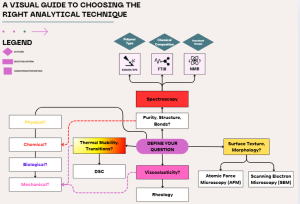Part 3: Polymer Characterization Methods
Characterization is a fundamental aspect of polymer and fiber research, essential for understanding their composition, structure, and performance. It links molecular design to material properties such as strength, flexibility, thermal stability, and chemical resistance, enabling the development of materials suited for specific applications in fields like composites, textiles, biomedicine, and packaging.
Polymers are complex macromolecular systems whose properties depend on molecular weight, chain architecture, crystallinity, and intermolecular interactions. Characterization techniques such as FTIR, NMR, GPC, and Mass Spectrometry reveal molecular structures and bonding, while DSC, TGA, DMA, and rheological studies provide insight into thermal behavior, degradation, and viscoelastic performance. Similarly, techniques like SEM, AFM, and XRD help visualize morphology, crystallinity, and surface features.
Recent advances in analytical instrumentation have transformed the field of polymer and fiber characterization. High-resolution imaging, nanoscale mapping, and computational modeling now enable the correlation of molecular structure with macroscopic performance in detail. The integration of experimental data with predictive simulations and machine learning approaches further enhances our ability to design and tailor materials with specific properties.
Overall, characterization serves as a bridge between polymer synthesis and application. By combining chemical, thermal, mechanical, and morphological analyses, researchers can achieve a holistic understanding of a material’s behavior, ensure consistency in industrial applications, and accelerate innovation in polymer science and engineering.

Figure: A guide to choosing the right analytical technique
